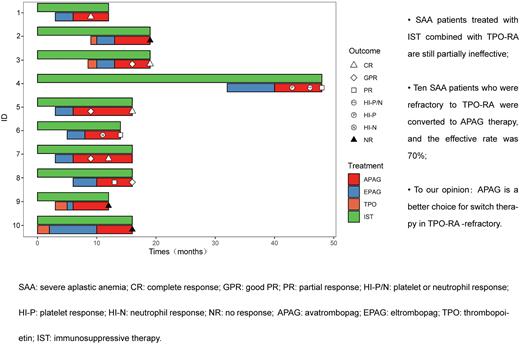Abstract
ATG combined with CsA is the first-line treatment for patients with SAA who cannot choose HLA-matched HSCT because of various conditions. The HR rate is only approximately 60-80%, and the CR is not high. The lack of residual HSC in patients is an important reason for this unsatisfactory effect. RhTPO/TPO-RA combine with HSC membrane receptors to promote their proliferation and differentiation, expand multipotent hematopoietic progenitor cells in vivo. Studies have found that TPO-RA eltrombopag (EPAG) combined with IST can significantly increase the HR rate and improve the quality of the HR. From 40-50% hematologic improvement can also be obtained with refractory SAA. However, TPO-RA treatment is ineffective in some patients. Avatrombopag (APAG) acts on the transmembrane region of the TPO receptor, has a stronger effect than EPAG, and has no obvious liver toxicity. We analyzed the efficacy and safety of IST combined with rhTPO and/or EPAG in patients with SAA of switching to APAG.
We retrospectively analyzed the data of 10 patients who were hospitalized between January and December 2021. All patients have been diagnosed with V/SAA. They received IST combined with rhTPO/TPO-RA treatment, failed to obtain a HR, and were converted to APAG. The patients were treated with IST for at least 6 months, combined with rhTPO and/or EPAG for at least 3 months, and did not get HR. None of the patients included in this study was suitable for undergo allogeneic HSCT.
APAG was administered orally at a dose of 40 mg/day once a day for at least 6 months.The efficacy criteria for refractory SAA were defined as follows: one-line response included platelet response (HI-P), neutrophil response (HI-N), and erythroid response (HI-E). The 2-line HR could be a combination of any two of the aforementioned one-line responses. A trilineage response was defined as a patient with simultaneous platelet, erythroid, and neutrophil responses, and the quality of the trilineage response was the same as that of the initial treatment with SAA/TDNSAA.
Ten patients were included in the study, with a median age of 54 (14-68) years, including five males and five females. All patients received IST for a median of 8.5 (6-40) months. Four patients received rhTPO for 1-2 months followed by EPAG for 2-8 months. Six patients received only EPAG for 3-4 months. All the patients received rhTPO/TP-RA for a median of 3.5 (3-10) months. Five patients with PNH clones were positive by flow cytometry, and there was no hemolytic or biochemical evidence of hemolysis. Two patients had clonal chromosomal abnormalities: one with 47,XY; +8 [2/20] and the other with 45,XY; -Y [10/20].
Ten patients were converted to APAG treatment for a median of 6 (6-10) months. After 3 months of follow-up , seven patients obtained a HR (7/10, 70%), of which two patients obtained a HI-P and HI-N, and five patients (5/10, 50%) obtained a three-line HR (1-CR, 3-GPR, 1-PR). Seven patients (7/10, 70%) obtained HR after 6 months of follow-up, of which one patient obtained HI-P/N and six patients (6/10, 60%) obtained three-line HR (3-CR, t2-GPR, 1-PR). The patient with two-line HR further improved after 8 months of APAG, reaching a three-line blood cell response to PR. At the end of the last follow-up, the HR rate of all patients with APAG conversion therapy was 70%, and all of them achieved three-line blood cell responses (4-CR, 1-GPR, 2-PR).
During the follow-up period, no APAG-related adverse events of grade 2 or above were found in any patient, no thrombotic events occurred, and no fibrous tissue hyperplasia was found in the bone marrow pathology review after 6 months of treatment. Among the five patients with PNH clones before APAG conversion therapy, three patients did not change significantly. Otherwise one patient's granulocyte PNH clone decreased from 16.2% at baseline to 6.3%, and the other patient's PNH clone increased from 9.8% at baseline to 19.6%, whereas there was no symptomatic hemolysis in all patient. One patient (1/10, 10%) with normal chromosomal before therapy get a new clonal chromosomal abnormality after 3 months. It was 46XX, t(X;4 )(p11.4;q21) [4/20]; the HR was assessed as GPR.
In conclusion, patients with SAA refractory to TPO-RA, drug conversion therapy can be based on the safety, pharmacological, and pharmacodynamic characteristics of TPO-RA drugs. Therefore, APAG is a better choice for switch therapy in these patients.
Disclosures
No relevant conflicts of interest to declare.
Author notes
Asterisk with author names denotes non-ASH members.


This feature is available to Subscribers Only
Sign In or Create an Account Close Modal